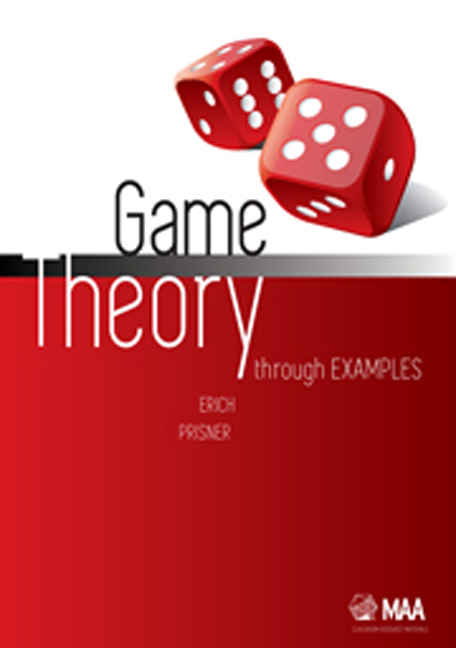Book contents
- Frontmatter
- Contents
- Preface
- 1 Theory 1: Introduction
- 2 Theory 2: Simultaneous Games
- 3 Example: Selecting a Class
- 4 Example: Doctor Location Games
- 5 Example: Restaurant Location Games
- 6 Using Excel
- 7 Example: Election I
- 8 Theory 3: Sequential Games I: Perfect Information and no Randomness
- 9 Example: Dividing A Few Items I
- 10 Example: Shubik Auction I
- 11 Example: Sequential Doctor and Restaurant Location
- 12 Theory 4: Probability
- 13 France 1654
- 14 Example: DMA Soccer I
- 15 Example: Dividing A Few Items II
- 16 Theory 5: Sequential Games with Randomness
- 17 Example: Sequential Quiz Show I
- 18 Las Vegas 1962
- 19 Example: Mini Blackjack and Card Counting
- 20 Example: Duel
- 21 Santa Monica in the 50s
- 22 Theory 6: Extensive Form of General Games
- 23 Example: Shubik Auction II
- 24 Theory 7: Normal Form and Strategies
- 25 Example: VNM POKER and KUHN POKER
- 26 Example: Waiting for Mr. Perfect
- 27 Theory 8: Mixed Strategies
- 28 Princeton in 1950
- 29 Example: Airport Shuttle
- 30 Example: Election II
- 31 Example: VNM POKER(2, r, m, n)
- 32 Theory 9: Behavioral Strategies
- 33 Example: Multiple-Round Chicken
- 34 Example: DMA Soccer II
- 35 Example: Sequential Quiz Show II
- 36 Example: VNM POKER(4, 4, 3, 5)
- 37 Example: KUHN POKER(3, 4, 2, 3)
- 38 Example: End-of-Semester Poker Tournament
- 39 Stockholm 1994
- Bibliography
- Index
24 - Theory 7: Normal Form and Strategies
- Frontmatter
- Contents
- Preface
- 1 Theory 1: Introduction
- 2 Theory 2: Simultaneous Games
- 3 Example: Selecting a Class
- 4 Example: Doctor Location Games
- 5 Example: Restaurant Location Games
- 6 Using Excel
- 7 Example: Election I
- 8 Theory 3: Sequential Games I: Perfect Information and no Randomness
- 9 Example: Dividing A Few Items I
- 10 Example: Shubik Auction I
- 11 Example: Sequential Doctor and Restaurant Location
- 12 Theory 4: Probability
- 13 France 1654
- 14 Example: DMA Soccer I
- 15 Example: Dividing A Few Items II
- 16 Theory 5: Sequential Games with Randomness
- 17 Example: Sequential Quiz Show I
- 18 Las Vegas 1962
- 19 Example: Mini Blackjack and Card Counting
- 20 Example: Duel
- 21 Santa Monica in the 50s
- 22 Theory 6: Extensive Form of General Games
- 23 Example: Shubik Auction II
- 24 Theory 7: Normal Form and Strategies
- 25 Example: VNM POKER and KUHN POKER
- 26 Example: Waiting for Mr. Perfect
- 27 Theory 8: Mixed Strategies
- 28 Princeton in 1950
- 29 Example: Airport Shuttle
- 30 Example: Election II
- 31 Example: VNM POKER(2, r, m, n)
- 32 Theory 9: Behavioral Strategies
- 33 Example: Multiple-Round Chicken
- 34 Example: DMA Soccer II
- 35 Example: Sequential Quiz Show II
- 36 Example: VNM POKER(4, 4, 3, 5)
- 37 Example: KUHN POKER(3, 4, 2, 3)
- 38 Example: End-of-Semester Poker Tournament
- 39 Stockholm 1994
- Bibliography
- Index
Summary
Pure Strategies
In everyday language we distinguish between strategic and tactical behaviors. While tactical reasoning concerns what to do in a particular situation, the strategic point of view considers the whole picture and provides a long-term plan. In game theory, a strategy spans the longest possible time horizon—it is a recipe telling the player what to do in any possible situation. Since a situation translates into an information set in games with imperfect information, a pure strategy for a player lists all information sets in which the corresponding player has to move, together with rules on how to move in each information set. By choosing a pure strategy, the player decides on how to play in all possible situations (i.e., information sets). Even unlikely situations must be considered in advance.
In real life, few people start a game prepared with a pure strategy: they would start playing and decide what to do when it is their turn. So a pure strategy is more a theoretical than a practical concept. Other players or independent observers would not be able to decide whether a player plays with an a priori strategy. All they see is that decisions are made at different positions, but they do not know when they have been made. So we may as well assume that players have made all their decisions before the game starts.
Let's see how you can list, count, and encode the pure strategies a player has in a game. Since in principle in an information set every choice of move is possible, the product of the numbers of choices taken over all information sets of that player is the number of a player's pure strategies. We encode a player's strategies by first numbering all his or her information sets arbitrarily. We abbreviate each choice by a single letter. Then a pure strategy can be encoded as an n-letter word, where n is the number of the player's information sets, and the kth letter of the word tells what alternative the player chooses at the kth information set.
Information
- Type
- Chapter
- Information
- Game Theory Through Examples , pp. 176 - 184Publisher: Mathematical Association of AmericaPrint publication year: 2014
